Find out information about our beautiful flora around the Kensington Bushland area.
Allocasuarina Fraseriana
Sheoak
Noongar name: Condil
Conservation status: Not threatened
Distribution:
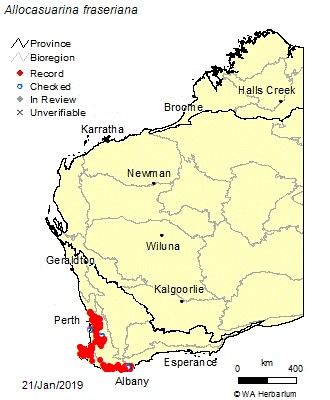
Description:
This species is dioecious, meaning it has separate male and female individuals. It is an erect tree, growing from 5-15m high, and has fibrous, reddish-brown bark. The flowers are an inconspicuous brown from May to October and produce a spiky round fruit.
Curious Facts:
- The Common Sheoak is the home for a great variety of insects, including three species of jewel beetle, long-horned beetles, ants and wasps.
- The Sheoak was vital to Noongar people’s spirituality as well as their social and emotional wellbeing. They sat under the tree and listened to the sounds of the foliage; they believed these were the whispers of the spirits of the old people talking to them.
References:
Florabase
Noongar Bush Medicine by Vivienne Hansen and John Horsfall.
Flora maps used with the permission of the Western Australian Herbarium, Department of Biodiversity, Conservation and Attractions (https://florabase.dpaw.wa.gov.au/help/copyright). Accessed on Tuesday, 27 August 2019.
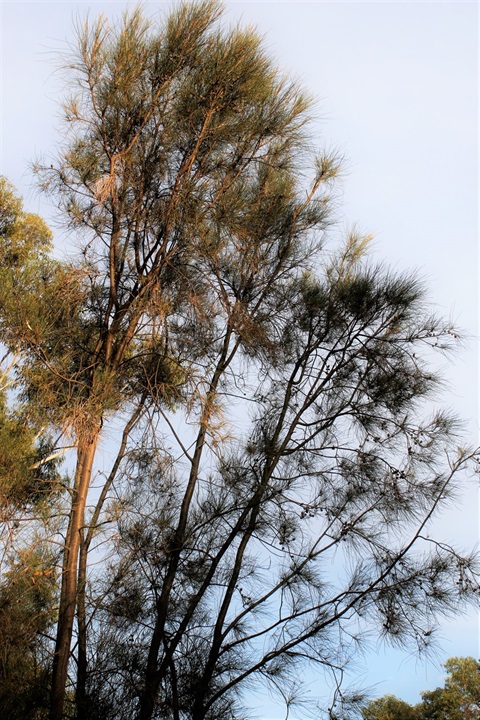
Banksia Attenuata
Candlestick Banksia - Banksia Attenuata
Noongar name: Piara
Conservation status: Not threatened
Distribution:
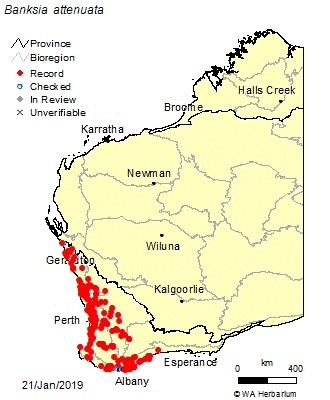
Description:
Banksia attenuata gets its common name from the shape of its flowers, which are long, slender and yellow, like a candlestick. Like other banksias, it has lignotubers and epicormic buds, which help the tree to recover after fire. It grows from 0.4 to 10m high and flowers from October to December or January to February.
Curious facts:
- Mature trees are rarely killed by fire, even the young trees that are burnt to the ground will resprout from its rootstock.
- Noongar people would make infusions of the flower (made by dipping them in water) to relieve coughs and sore throats. Also made for refreshing drinks.
References:
Florabase
Noongar Bush Medicine by Vivienne Hansen and John Horsfall.
Flora maps used with the permission of the Western Australian Herbarium, Department of Biodiversity, Conservation and Attractions (https://florabase.dpaw.wa.gov.au/help/copyright). Accessed on Tuesday, 27 August 2019.
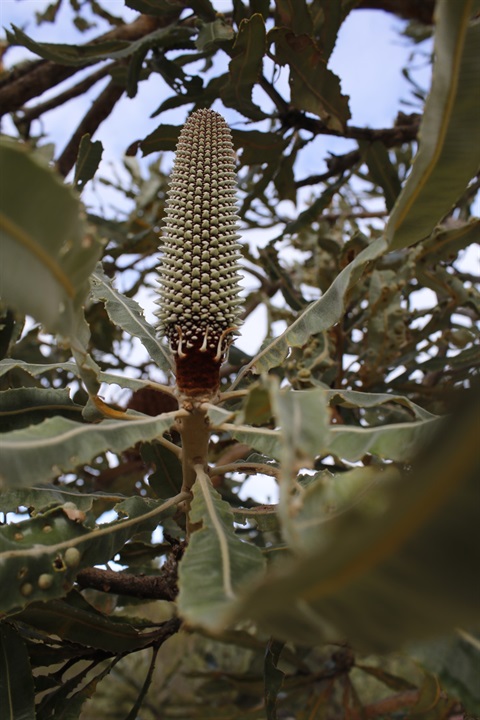
Holly-leaved Banksia
Banksia ilicifolia
Conservation Status: Not threatened
Distribution:
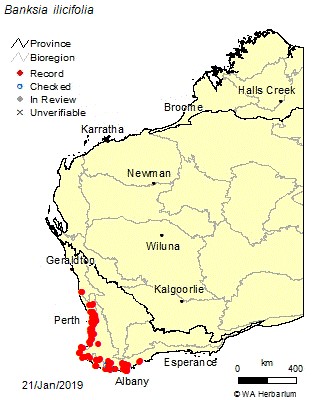
Description:
This banksia is a very erect tree and can grow up to 12m high. The flowers change colour over time from January to December, and the glossy, spiky green leaves are reminiscent of English holly leaves. Like many native plants, this species has epicormic buds which can sprout vigorously after fire. There are only a few of these in the bushland, so keep an eye out!
Curious Facts:
- The flowers go through three colour phases - first yellow, then pink and then finally red to help attract pollinators.
References:
Florabase
Flora maps used with the permission of the Western Australian Herbarium, Department of Biodiversity, Conservation and Attractions (https://florabase.dpaw.wa.gov.au/help/copyright). Accessed on Tuesday, 27 August 2019.
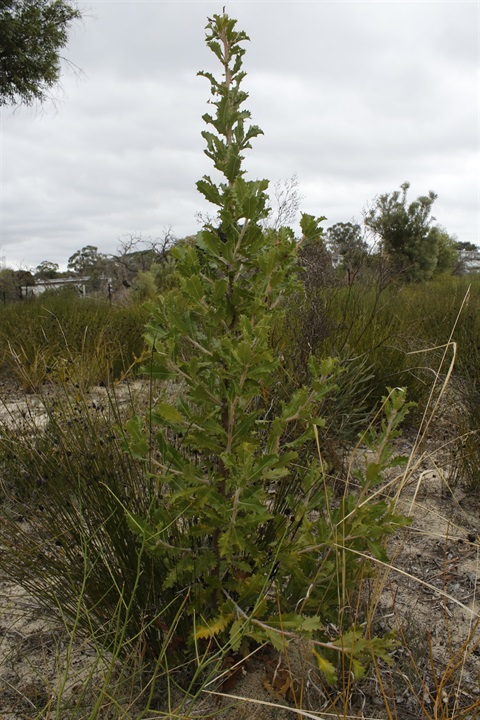
Firewood Banksia
Banksia Menziesii
Conservation Status: Not threatened
Distribution:
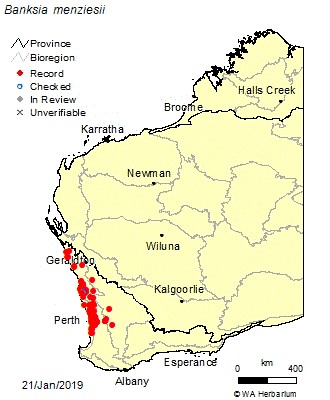
Description:
This iconic Perth tree can grow to 7m high, but are more often around 3m in the bushland. They sprout from lignotubers or epicormic buds, especially after fire. The large flower heads are actually an inflorescence, made up of hundreds of tiny flowers. As the flowers open from the base up, they change in appearance from pink to a more orange colour, leading to the distinctive acorn shaped flower head. These beautiful flowers are a staple for native birds from February to October, and range in colour from pink to red to orange or yellow. In Kensington Bushland, they are generally pink and orange.
Curious Facts:
- Noongar people steeped the flowers in water to make a sweet drink or to help relieve coughs and colds, and make a refreshing drink.
References:
Florabase
Noongar Bush Medicine by Vivienne Hansen and John Horsfall.
Flora maps used with the permission of the Western Australian Herbarium, Department of Biodiversity, Conservation and Attractions (https://florabase.dpaw.wa.gov.au/help/copyright). Accessed on Tuesday, 27 August 2019.
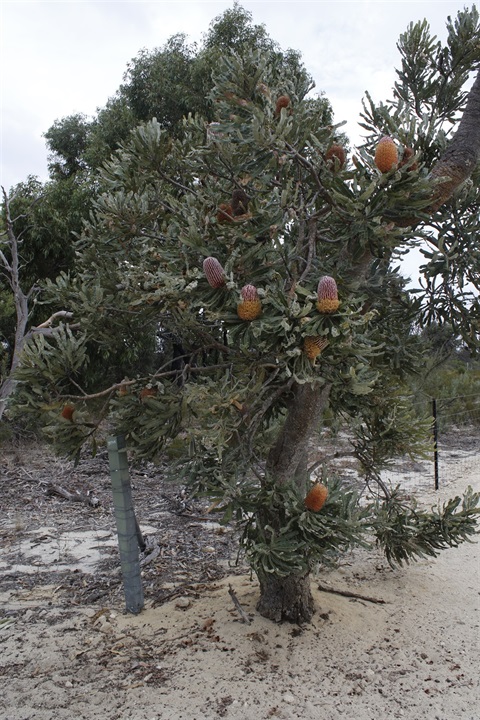
Eucalyptus Marginata
Eucalyptus marginata
Noongar Name: Jarrah
Conservation Status: Not threatened
Distribution:
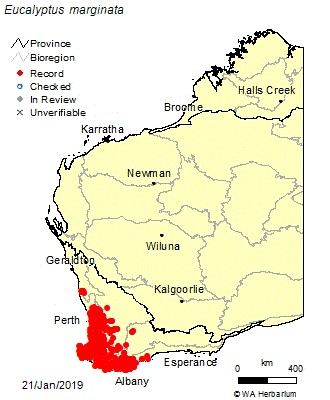
Description:
This tree can grow up to 40m high and has rough fibrous bark. The small flowers are white-cream and pink from June to December/January. After flowering the round hard fruits can often be found on the ground below.
Curious Facts:
- World-renown for beautiful rosy-red grained timber.
- In flower the pollen is keenly sought after for its highly nutritious pollen that makes wonderful medicinal honey.
References:
Florabase
Flora maps used with the permission of the Western Australian Herbarium, Department of Biodiversity, Conservation and Attractions (https://florabase.dpaw.wa.gov.au/help/copyright). Accessed on Tuesday, 27 August 2019.
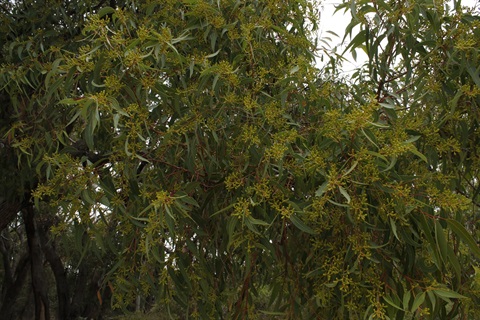
Eucalyptus Todtiana
Prickly Bark - Eucalyptus todtiana
Noongar name: Dwutta
Conservation status: Not threatened
Distribution:
The Prickly bark’s range extends from the Murray River, east of Mandurah, to the Arrowsmith River, near Dongara. The further north its distribution, the more widespread its occurrence. South of the Swan River it is confined to Bassendean sands where it grows in association with Banksias. Its absence from the more fertile soils further south probably illustrates competition among eucalypts as larger species dominate and exclude it.
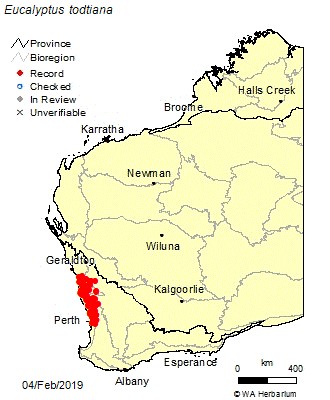
Description:
The Prickly bark is a small to medium sized tree which is broader than it is tall. E. todtiana can be easily recognised in the field by its often sprawling habit and yellowish, rough bark on the trunks and branches. When flowering, the masses of white flowers on drooping branches are in stark contrast to the dullish foliage.
Curious facts:
- This stout and spreading tree has a thick, rough bark with prickly fine fibres to touch, that’s where it gets its name.
- Aboriginal people would use crushed leaves as antibacterial poultices for healing wounds. They were also used in steam pits and held, crushed, under the nose to relieve congestion due to colds and flu. Leaves were also eaten to relieve dysentery. The gum was also used on sores as an ointment. Leaves from the tree were also commonly used for bedding.
- This slow growing long lived species is a habitat tree for many local fauna, such as nectar-feeding birds, bats, lizards and insects.
- Eucalyptus is from the Greek words eu, meaning well and calyptos, meaning covered. It refers to the operculum or cap which covers the stamens in bud. Todtiana is named in honour of Emil Todt, a botanical artist.
References:
Eucalypts of Western Australia’s Wheatbelt by Malcolm French 2012
Leaf and Branch, Trees and tall shrubs of Perth by Robert Powell 2009
Noongar Bush Medicine by Vivienne Hansen and John Horsfall
Florabase
Flora maps used with the permission of the Western Australian Herbarium, Department of Biodiversity, Conservation and Attractions (https://florabase.dpaw.wa.gov.au/help/copyright). Accessed on Tuesday, 27 August 2019.
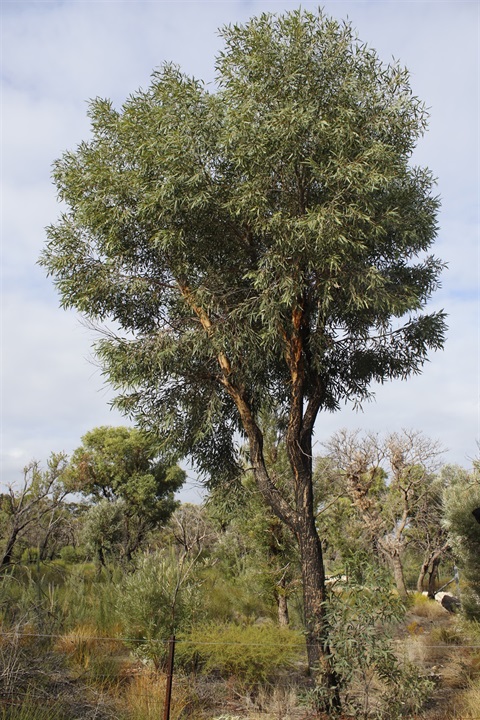
Nuytsia Floribunda
WA Christmas tree - Nuytsia floribunda
Noongar name: Mooja or Mudjar
Conservation status: Not threatened
Distribution:
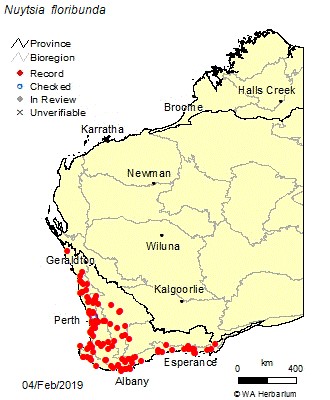
Description:
This large tree grows to 10m high and is semi-parasitic. The bark is rough and grey-brown. The Christmas tree got its common name due to the fact that it flowers in the months leading up to Christmas. These flowers are in very large, drooping inflorescences of a bright yellow-orange.
Curious facts:
- The largest of all the mistletoe family, this semi-parasite has roots that attach to nearby trees and shrubs to extract water and nutrients.
- The Christmas tree (Nuytsia floribunda) has blades for slicing into the roots of plants to steal their sap. The blades are sharp enough to draw blood on human lips.
References:
Florabase
Australian Geographic
Flora maps used with the permission of the Western Australian Herbarium, Department of Biodiversity, Conservation and Attractions (https://florabase.dpaw.wa.gov.au/help/copyright). Accessed on Tuesday, 27 August 2019.
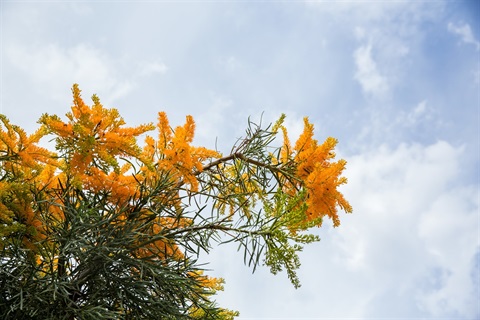
Burchardia Congesta
Milkmaids
Conservation Status: Not threatened
Distribution:
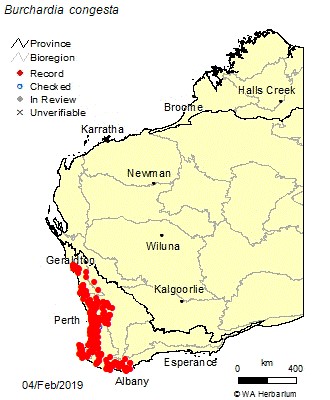
Description:
Open, erect tuberous, perennial, herb, grows to 0.8m high. Grows in Yellow-brown or black peaty or stony grey sand, brown-grey loam, brown-red sandy clay, ironstone, gravel, laterite, granite, quartz. Generally found on sand dunes, plains, uplands, valley slopes, ridges and hillsides tracks.
Curious Facts:
- The Noongar people would gather and eat the fleshy white edible root tubers of this herb when it appears annually in August to October.
References:
Florabase
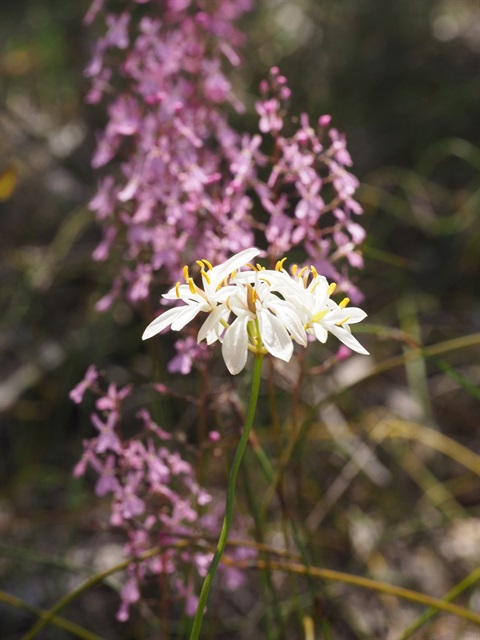
Caladenia Flava
Cowslip Orchid
Conservation Status: Not threatened
Distribution:
The Cowslip orchid is common throughout the south west, growing in a range of soil types including laterite and granite. It often occurs with burnt trees, especially marri, and is found in winter wet areas, forest, coastal woodlands, and on granite outcrops throughout the south west and Eremaean botanical provinces. In Kensington Bushland, it can be found almost everywhere, often preferring the shade of larger shrubs and trees.
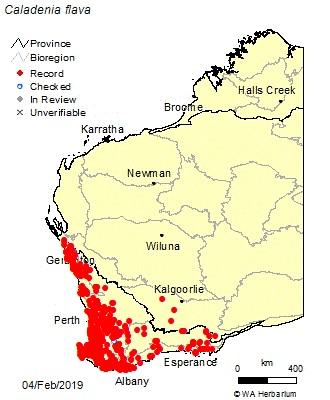
Description:
Cowslip orchids are tuberous, perennial herbs growing to approximately 0.3m high. Each plant grows a single green hairy leaf at its base and the stem can produce up to three predominately yellow-white flowers from July to December. Flowers are defined by having three sepals and three petals; one of these petals has been modified as a landing strip for pollinators called a labellum, creating a distinctive star shaped flower. Four subspecies are recognised but the most common and widespread is the Common cowslip orchid Caladenia flava subsp. flava. This subspecies is characterised by its deeper yellow coloring and variable red to brownish markings (stripes and spots), in some cases these marking are completely absent.
Curious Facts:
- The family ORCHIDACEAE is huge and consists world-wide of more than 25,000 species. South West Botanic Province is home to nearly 400 species of orchids of which all are terrestrial.
- Caladenia is from the Greek words calos, meaning beautiful, and aden meaning gland. Some species of Caladenia have colored glands at the base of the column. The column is an organ combining the stamens and style of the flower. Flava is from the Latin word flavus, meaning yellow.
- Orchids are a highly specialised group of plants, almost all species in the south west require a unique association with soil dwelling microbial fungi to grow.
References:
Florabase
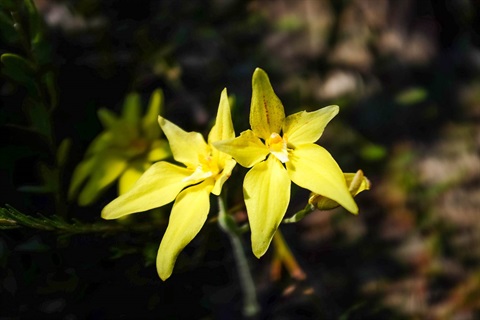
Hypocalymma Robustum
Swan River Myrtle
Conservation Status: Not threatened
Distribution:
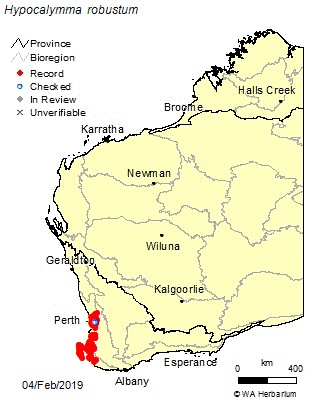
Description:
Erect shrub, 0.4-1(-1.5)m high. Flowering pink/pink-red, June to November. Gravelly lateritic soils, sandy soils. Undulating terrain, ridges.
References:
Florabase
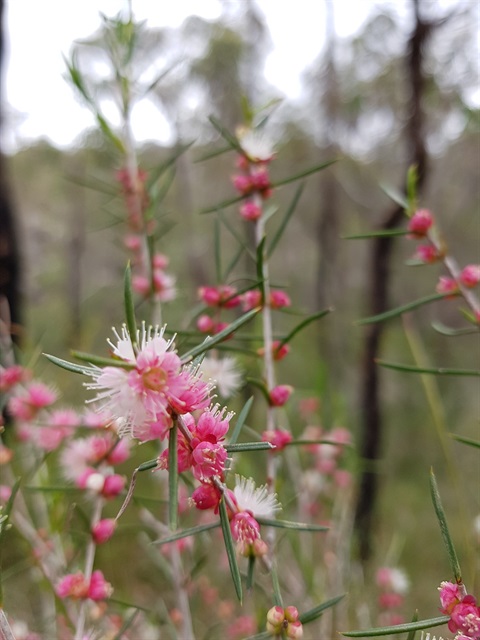
Macarthuria Australis
Conservation Status: Not threatened
Distribution:
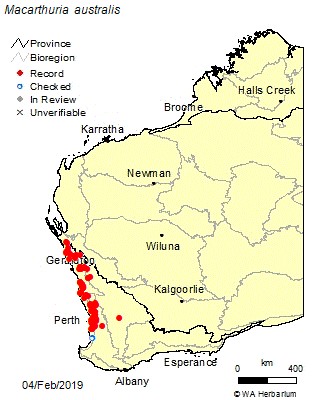
Description:
Erect or ascending, spreading, wiry shrub, 0.15-0.75m high. Flowering white/white-cream, May to December or January to February (mainly August to September). Generally growing in sand or laterite. Coastal sandplains, sandhills, roadsides.
Curious Facts:
- You can find many of these small wiry shrubs are a dominant understory plant particularly on the eastern half of the bushland.
References:
Florabase
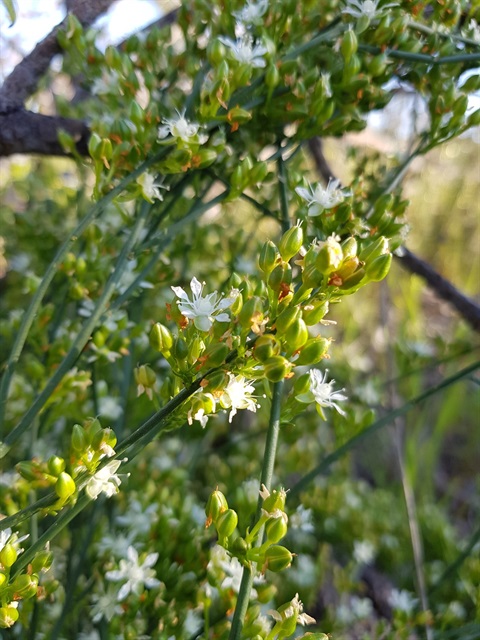
Patersonia Occidentalis
Purple Flag
Noongar Name: Komma
Conservation Status: Not threatened
Distribution:
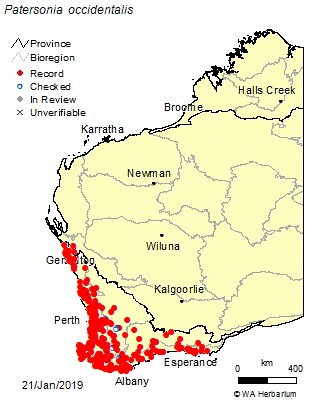
Description:
Rhizomatous, tufted perennial, herb, growing to 1.5m high. Flowering purple, August to December/January. Growing in grey-brown sand or sandy clay, red-brown clayey loam, gravel, laterite, ironstone, granite, limestone. Winter-wet areas, dunes, granite outcrops.
Curious Facts:
- The distinctive three petal purple flower only last one day but is quickly replaced in succession by new flowers.
References:
Florabase
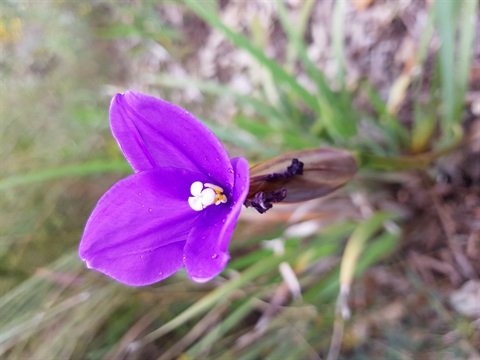
Petrophile Linearis
Pixie Mops
Conservation Status: Non threatened
Distribution:
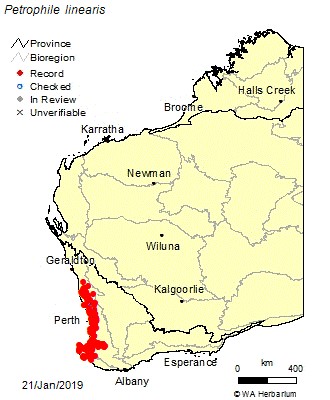
Description:
A common woody shrub growing to 1m with interesting thick curved blue-green leaves and a striking pale pink furry flower head. It flowers between August and December.
References:
Florabase
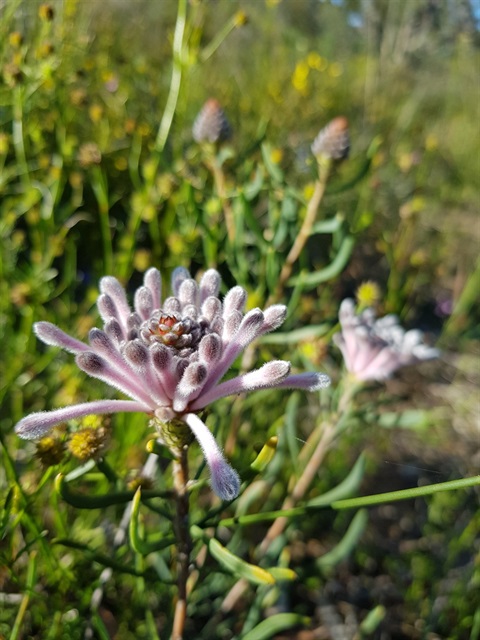
Podotheca Gnaphalioides
Golden Long-heads
Distribution:
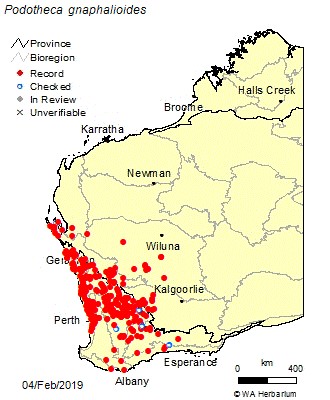
Description:
Erect or decumbent, often viscid annual, herb, 0.02-0.6m high. Flowering yellow/orange-yellow, August to November. Grows in a variety of soils, tends to favour sandy soils.
References:
Florabase
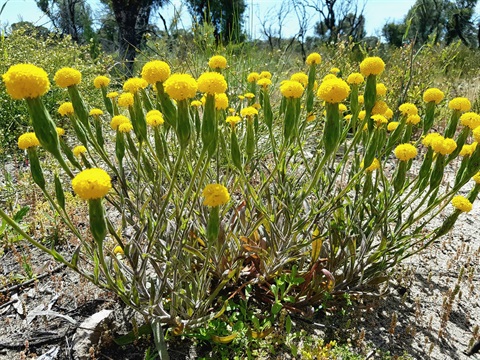
Stirlingia Latifolia
Blueboy
Conservation Status: Not threatened
Distribution:
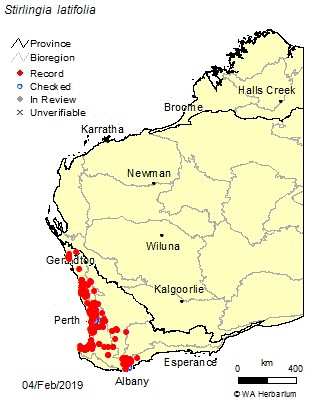
Description:
Erect, lignotuberous shrub, 0.2-1.5m high. Flowers yellow/yellow-brown/red-brown, August to October. Grows in White, grey, yellow/brown or black sand, sometimes with lateritic gravel.
Curious Facts:
- One of the most dominant understory species to look for in the bushland. The “Blueboy” displays clusters of yellow, brown and red flowers held high above the foliage on large leafless stems.
- A highly sought after plant for the cut-flower market.
References:
Florabase
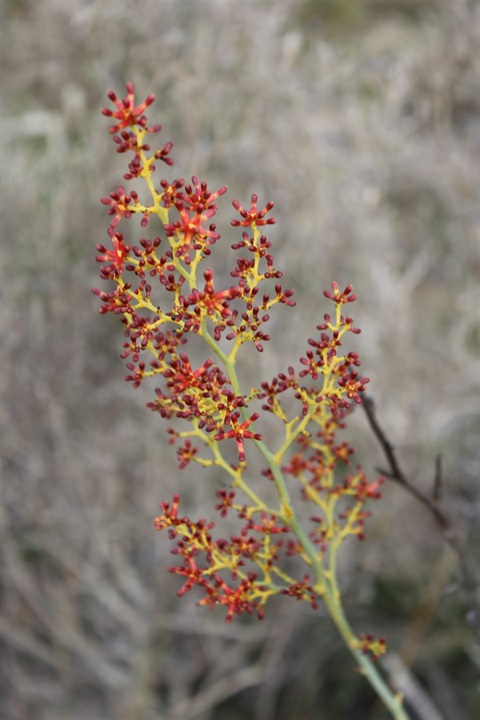
Xanthorrhoea Brunonis
Xanthorrhoea
Noongar name: Balga
Conservation status: Not threatened
Distribution:
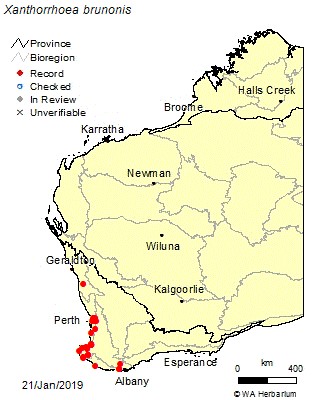
Description:
This Xanthorrhoea species clumps at ground level with little or no truck and sends up a 1 to 1.5m flowering scape with white-cream flowers densely packed at the top. These clusters of flowers can often be seen covered with feeding bees and native wasps. Flowers from October to December.
Curious facts:
- There are 30 species of grasstrees in Australia and some can live up to 600 years old. The species found in Kensington bushland (Brunonis) has a very short trunk if any at all, leaks a yellow gum from the stem, and is only found in south west WA.
- Aboriginal people would use this for medicinal purposes. The gum is a normative and was chewed to relieve both diarrhoea and constipation.
References:
Florabase
Noongar Bush Medicine by Vivienne Hansen and John Horsfall.
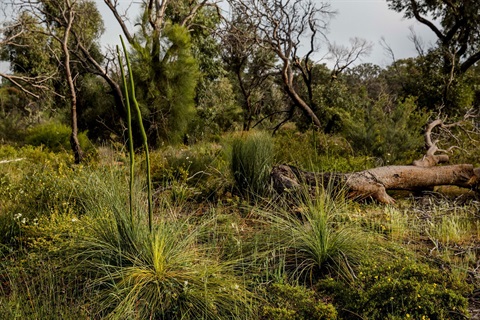
In the video below, Town Urban Ecosystems Supervisor Bushy explains the importance of Jirdarup Bushland to the Town's ongoing efforts to expand our urban canopy. Learn more about our Urban Forest planting programs here.